Hello fellow readers, About a year ago, I enjoyed a visit to a free public garden managed by the Morris County Park Commission tucked away in Far Hills, NJ, which became a column topic titled Wandering Willowwood Arboretum. Bruce Crawford, formerly the Director of Rutgers Gardens, joined the park commission as Manager of Horticulture, which brings a memory of a talk he gave a handful of years ago he coined Sexy Native Plants. The G-rated version – Native Plants for Native Pollinators.
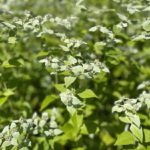
Short-toothed Mountain Mint (Pycnanthemum muticum)
How do we define native plants?
Bruce shared his philosophy on the definition of native plants, which can be confusing. “Is it a plant naturally growing only in your county, your state, or your regional portion of the country?” Instead, he feels “a garden is an art form created by human hands” (I love that philosophy!) and says, “Cultivars, which are either created or reproduced through human hands, are therefore acceptable.”
Bruce Crawford’s “Sexy Native Plants”
We’ve spoken about the layers of plants found in nature and well-designed gardens; and how the groundcover layer can be an ecological and beautiful alternative to mulching. Bruce touts the weed-free benefits of Mountain Mint (Pycnanthemum muticum), which spreads ambitiously by rhizomes (underground stems) without being invasive. Its blue-green fuzzy leaves create a silvery 2 to 3-foot-tall blanket in the sun or shade that tolerates dryness, though it prefers to be moist. Pollinators love its pinkish-white flowers in late summer.
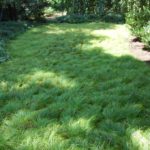
Lovely waves of green in August
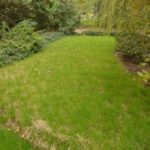
Waking up in May
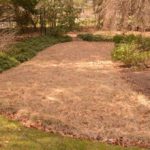
Pennsylvania sedge in March
Photos by Bruce Crawford
How about a hands-free groundcover such as Pennsylvania sedge (Carex pennsylvanicum)? “No cutting, no weeding, no watering,” boasts Bruce, “and you can walk on it.” It’s best in full shade and can endure wetness for a while, but it prefers to be dry. This grass-like beauty is 14 inches tall but lays in soft waves about 8 inches high. It grows fine under trees and makes a perfect lawn alternative in dry shady areas.

Prairie Dock (Silphium terebinthinaceum)
Photo by Bruce Crawford
Prairie Dock and Switchgrass make great companions.
Then there’s Prairie Dock (Silphium terebinthinaceum) with its long, almost leafless flower stems leading to three-inch sunflower-like blooms in summer. The flower stems rise seven feet above the 2-foot-high foliage, which “looks great with tall grasses in full sun,” flaunts Crawford, who adores this plant. It attracts beneficial Insects such as native bees and provides a habitat for them, nesting below or harvesting plant parts to hunker down elsewhere.
For a tall grass companion to Prairie Dock, there’s ‘Dallas Blues’ Switchgrass (Panicum virgatum), growing 6 to 8 feet in full sun but can handle a bit of shade. Unfortunately, it loses its blueness when it flowers pinkish spikes. However, come Fall, the outstanding burnt yellow color is worth the wait.
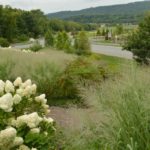
Panicum virgatum ‘Dallas Blues’ with Hydrangea paniculata ‘Limelight’ at Cascades Hotel in Hamburg, NJ
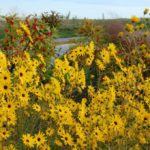
Swamp Sunflower (Helianthus angustifolius)
Photo by Bruce Crawford
The flower of Swamp Sunflower (Helianthus angustifolius) looks much like black-eyed Susan. She’s a prolific bloomer in the Fall until frost. She may need staking, but given a site in full sun and plenty of moisture, she will stand tall at about 6 feet.
Accolades for my favorite large woody shrub
I was thrilled to hear accolades for my favorite large woody shrub Bottlebrush Buckeye (Aesculus parviflora). However, it’s the first I heard of the variety ‘Serotina’ growing taller than the straight species to 20 feet. And its bottlebrush-like blooms appear about three weeks later, typically in August. Note to self to add a swath to extend the flowering time of my beloved buckeyes.
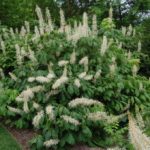
Bottlebrush Buckeye (Aesculus parviflora var. serotina)
Photo by Bruce Crawford
I’d love to revisit Willowwood Arboretum to see what changes are underway. Perhaps you’d like to join me? If so, please email me at AskMaryStone@gmail.com.
Meanwhile, it’s an ideal time to dig in some of Bruce Crawford’s Sexy Native Plants. Not only are they deer resistant they are G-rated for Glorious and Good for pollinators.
Garden Dilemmas? AskMaryStone@gmail.com and your favorite Podcast App.
Native Plant Societies can help you find more native plants in your area.
There’s more to the story in Episode 74 of the Garden Dilemmas Podcast:



